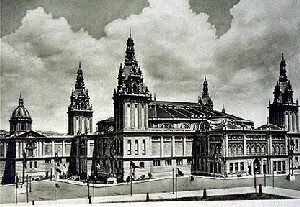|
1 2 3 4 |
 Copyright: Exposición Internacional Barcelona 1929 |
The broad Avenida de la Reina María Cristina was the most important road on the exposition grounds from the main entrance up to Montjuich: Its crowning glory was the imposing National Palace, the largest building at the world exposition. Completely dedicated to culture, it was a monument designed to unify the nation. The organisers had discussed and debated the idea of this building for more than twenty years. In 1909 the idea was to mimic the Eiffel tower by it being the highlight of the event. As a temple of the arts, it was to counterbalance the giant industrial halls of previous world expositions, for example the Crystal Palace in London 1851 or the Rotunda in Vienna 1873.
The highly influential Catalonian architect, Puig y Cadafalch, presented a first draft dominated by simple symmetrical forms with classic decorative elements. However, after the military dictatorship came to power in Madrid, a competition was organised for the design of the central building, and won by Enrique Catá and Pedro Cendoya. Although the new designs were not major departures from Puig's concept, in particular the designs of the facades were much more blatantly three-dimensional demonstrations of Spanish unity. The monumental building with symmetrical axes, divided into a central elevated tower and subordinate corner pavilions, was reminiscent of the Royal castle at Escorial. The four high towers flanking the Festival Hall harked back to the large Spanish cathedrals of Santiago de Compostela and Saragossa. The bold combination of sacral and profane architecture drawn from all parts of the country was only feasible in that the architects resorted to the academic eclecticism of the 19th century. Modern architecture this was not.
Behind the high-rising dome of the vestibule was a Festival Hall built using modern engineering techniques with a capacity for 20,000 persons. Although the dome above the hall was the largest in the country, it could not be seen from the show-side of the National Palace. Here as well, the reinforced concrete ribs of the dome were supported on ten metre high, finely decorated Corinthian double columns. The other halls in the building were also built using steel-reinforced concrete. As always at world expositions, the building work had a strict and punishing schedule. To meet the timetable, the entire interior work was fabricated on site using plaster and stucco panels. The palace, with its Festival Hall, offered sufficient space for a large exhibition of Spanish art, comprising 5,000 artefacts drawn from many museums, churches and private collections. Overall, the works of art presented, ranging from Romance Spain through to pictures by great artists like Velazquez and Goya presented an unparalleled tour de force of Spanish creativity. The exhibition spread across two storeys, while the cellar was reserved for the archaeological department. Modern art was hosted in a separate building behind the National Palace. Unfortunately, due to inadequate labelling of the objects and the lack of an exhibition catalogue, very few visitors were able to fully appreciate the extent of the collection. Much more informative was a room presenting 32 dioramas depicting the most important events in the history of the country.
At night in particular, the Avenida de la Reina María Cristina and the National Palace presented breathtaking spectacles. Coloured spotlights illuminated the buildings and the rhythmically changing shapes and forms of the fountains. Giant pylons made of orange-yellow glass, "Vitrolux", accentuated the central axis of the exposition grounds. Behind the blue-lit facade of the National Palace, between towers picked out in red floodlights, gigantic parabolic arc lights directed white, yellow, red and blue skybeams into the night.
| Year: 1929 | City: Barcelona | Country: Spain |
| Duration: 20 May 1929 - 15 January 1930 | ||